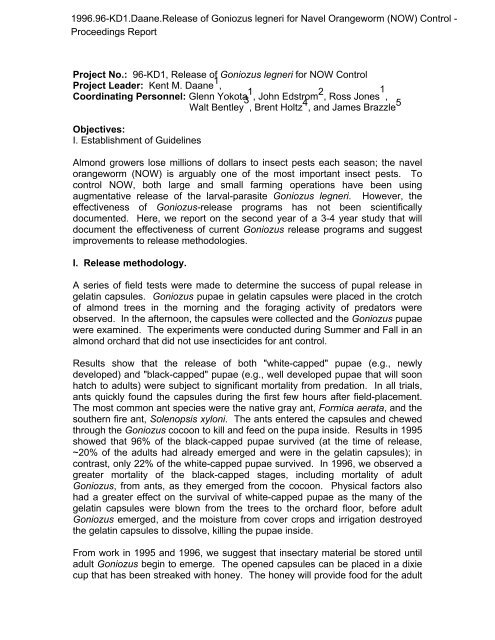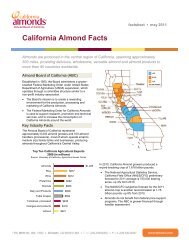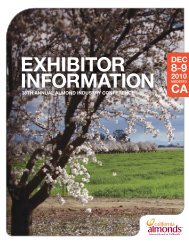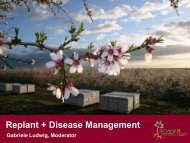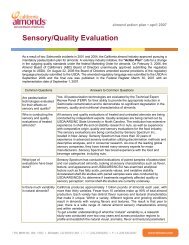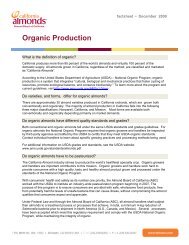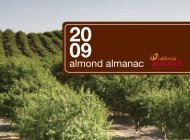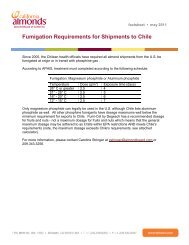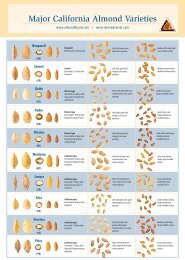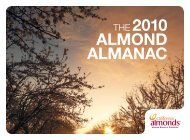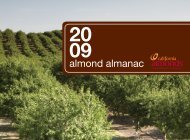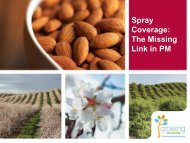Release of Goniozus legneri for Navel Orangeworm (NOW)
Release of Goniozus legneri for Navel Orangeworm (NOW)
Release of Goniozus legneri for Navel Orangeworm (NOW)
You also want an ePaper? Increase the reach of your titles
YUMPU automatically turns print PDFs into web optimized ePapers that Google loves.
Project No.: 96-KD1, <strong>Release</strong> <strong>of</strong><strong>Goniozus</strong> <strong>legneri</strong> <strong>for</strong> <strong>NOW</strong> ControlProject Leader: Kent M. Daane 1 ,Coordinating Personnel: Glenn Yokota 1 , John Edstrom 2 , Ross Jones 1 ,Walt Bentley 3 , Brent Holtz 4 , and James Brazzle 5Objectives:I. Establishment <strong>of</strong> GuidelinesAlmond growers lose millions <strong>of</strong> dollars to insect pests each season; the navelorangeworm (<strong>NOW</strong>) is arguably one <strong>of</strong> the most important insect pests. Tocontrol <strong>NOW</strong>, both large and small farming operations have been usingaugmentative release <strong>of</strong> the larval-parasite <strong>Goniozus</strong> <strong>legneri</strong>. However, theeffectiveness <strong>of</strong> <strong>Goniozus</strong>-release programs has not been scientificallydocumented. Here, we report on the second year <strong>of</strong> a 3-4 year study that willdocument the effectiveness <strong>of</strong> current <strong>Goniozus</strong> release programs and suggestimprovements to release methodologies.I. <strong>Release</strong> methodology.A series <strong>of</strong> field tests were made to determine the success <strong>of</strong> pupal release ingelatin capsules. <strong>Goniozus</strong> pupae in gelatin capsules were placed in the crotch<strong>of</strong> almond trees in the morning and the <strong>for</strong>aging activity <strong>of</strong> predators wereobserved. In the afternoon, the capsules were collected and the <strong>Goniozus</strong> pupaewere examined. The experiments were conducted during Summer and Fall in analmond orchard that did not use insecticides <strong>for</strong> ant control.Results show that the release <strong>of</strong> both "white-capped" pupae (e.g., newlydeveloped) and "black-capped" pupae (e.g., well developed pupae that will soonhatch to adults) were subject to significant mortality from predation. In all trials,ants quickly found the capsules during the first few hours after field-placement.The most common ant species were the native gray ant, Formica aerata, and thesouthern fire ant, Solenopsis xyloni. The ants entered the capsules and chewedthrough the <strong>Goniozus</strong> cocoon to kill and feed on the pupa inside. Results in 1995showed that 96% <strong>of</strong> the black-capped pupae survived (at the time <strong>of</strong> release,~20% <strong>of</strong> the adults had already emerged and were in the gelatin capsules); incontrast, only 22% <strong>of</strong> the white-capped pupae survived. In 1996, we observed agreater mortality <strong>of</strong> the black-capped stages, including mortality <strong>of</strong> adult<strong>Goniozus</strong>, from ants, as they emerged from the cocoon. Physical factors alsohad a greater effect on the survival <strong>of</strong> white-capped pupae as the many <strong>of</strong> thegelatin capsules were blown from the trees to the orchard floor, be<strong>for</strong>e adult<strong>Goniozus</strong> emerged, and the moisture from cover crops and irrigation destroyedthe gelatin capsules to dissolve, killing the pupae inside.From work in 1995 and 1996, we suggest that insectary material be stored untiladult <strong>Goniozus</strong> begin to emerge. The opened capsules can be placed in a dixiecup that has been streaked with honey. The honey will provide food <strong>for</strong> the adult
<strong>Goniozus</strong> and increase their field longevity. To complete this release program,we have to determine the movement <strong>of</strong> adult <strong>Goniozus</strong> in the field to determinehow many release sites per acre will provide adequate distribution <strong>of</strong> insectarymaterial.II. <strong>Release</strong> effectiveness.To scientifically evaluate <strong>Goniozus</strong> releases, we developed a methodology todetermine field parasitism rates. First, <strong>NOW</strong> are produced in a laboratory colony.Then, when the <strong>NOW</strong> larvae reach the second instar they are used to inoculateunshelled almond nuts. The inoculated nuts are stored singly in the cells <strong>of</strong>plastic rearing containers and held at 82°F. After ~7 days, larval development isobserved and those nuts that have been successfully infested with an <strong>NOW</strong>larvae are removed and stored at 55°F to slow <strong>NOW</strong> development. For fieldexperiments, the "sentinel nut" is placed into a wire cage (~2 sq inches) that canbe stapled to the almond tree.Experiments used either a replicated split-plot design with <strong>Goniozus</strong>-release orno-release plots in a single orchard, or paired orchard blocks. In all tests, 100sentinel nuts were spaced evenly throughout each plot. <strong>Goniozus</strong> were thenreleased at rates between 350-700 <strong>Goniozus</strong> per acre (typical release rates arebetween 250-350 <strong>Goniozus</strong> per acre per release). After 14-21 days, sentinelnuts were removed and the number <strong>of</strong> <strong>NOW</strong> parasitized was recorded. Thecommercial orchards used were between 40-90 acres in size, allowing <strong>for</strong> largeplot size to reduce movement <strong>of</strong> <strong>Goniozus</strong> between plots or orchards. Thesefield tests were conducted in Butte, Merced, Madera, Kings, and Kern Counties.Data from these trials are currently being analyzed. However, a preliminaryanalysis indicates that in orchards with low <strong>NOW</strong> pressure (e.g., nut infestationrates <strong>of</strong> 10%), <strong>NOW</strong> parasitism rates were generallyhigher, between 10-40%. However, the increase in percent parasitism was notenough to lower high <strong>NOW</strong> populations to acceptable levels. In our trials, thedata indicate that changes in release methods or release rates are neededbe<strong>for</strong>e would <strong>Goniozus</strong> releases can be used to lower high density <strong>NOW</strong>populations in a single season.III. Overwintering Sanitation.One <strong>of</strong> the more controversial practices that has been suggested is theincomplete removal <strong>of</strong> overwintered mummies to supply overwintering host sites<strong>for</strong> <strong>Goniozus</strong>. The following experiment is based on these facts: overwinteringalmonds serve as a host <strong>for</strong> <strong>NOW</strong>, orchard sanitation reduces <strong>NOW</strong> infestation
ates, and there is a positive correlation between the numbers <strong>of</strong> overwinteringnuts and <strong>Goniozus</strong>. There<strong>for</strong>e, incomplete orchard sanitation will lead to highernumbers <strong>of</strong> <strong>NOW</strong> and <strong>Goniozus</strong>; however, the resulting levels <strong>of</strong> <strong>NOW</strong> percentparasitism or <strong>NOW</strong> nut infestation at harvest are not known.To investigate, we used 3 commercial orchards that have a <strong>NOW</strong> controlprogram <strong>of</strong> winter sanitation and <strong>Goniozus</strong> release. In each, a single 8-acresection was not sanitized, and all overwintering nuts were left on all trees. Theaverage number <strong>of</strong> mummies per tree was determined. Populations levels <strong>of</strong><strong>NOW</strong> and <strong>Goniozus</strong> in the overwintered nuts were determined every 2 months.More importantly, the number <strong>of</strong> <strong>NOW</strong> and <strong>Goniozus</strong> moving out from theunsanitized portion <strong>of</strong> each orchard was sampled to determine whetheroverwintering mummy nuts (combined with <strong>Goniozus</strong> release) provide a source<strong>of</strong> more <strong>NOW</strong> or <strong>Goniozus</strong>. To sample, transects were laid through eachorchard, <strong>NOW</strong> and <strong>Goniozus</strong> populations were monitored along these transectswith <strong>NOW</strong> egg traps and with sentinel nuts. At harvest, nuts will be taken fromthe unsanitized sections and at rows 1-10, 11-20, 21-30, and 31-40 away fromthe unsanitized section.Results showed that <strong>Goniozus</strong> did not overwinter as well as the <strong>NOW</strong>. Initialdata analysis shows that only the adult <strong>Goniozus</strong> stage made it through thewinter period. In contrast, <strong>NOW</strong> overwinters in the larval stage and there wasvery little mortality <strong>of</strong> <strong>NOW</strong> larvae in the nuts during this period. The biology <strong>of</strong><strong>Goniozus</strong> may explain the high winter mortality. This parasite was imported fromregions in Texas and Mexico where Winter temperatures are warmer than thosein Cali<strong>for</strong>nia's Central Valley. The <strong>Goniozus</strong> larval stages may simply not surviveat colder temperatures. To test, we are using temperature cabinets to developlife table parameters <strong>for</strong> each <strong>Goniozus</strong> stage (e.g., at what temperature can itsurvive). Because <strong>of</strong> the poor Winter survival, we don't believe that post harvest<strong>Goniozus</strong> release (e.g. late September-October) are as effective as Spring orSummer releases. This in<strong>for</strong>mation can also be used to develop a temperaturebased development model that will be combined with a model on <strong>NOW</strong>development to help determine proper release timing.Regional IPM Advisor, 4 Farm Advisor, Madera County, 5 Farm Advisor, KernCounty.Almond Board <strong>of</strong> Cali<strong>for</strong>nia Project Number: 96-KDI 1 Center <strong>for</strong> BiologicalControl, UC Berkeley; 2 Farm Advisor, Colusa County, 3 UC


